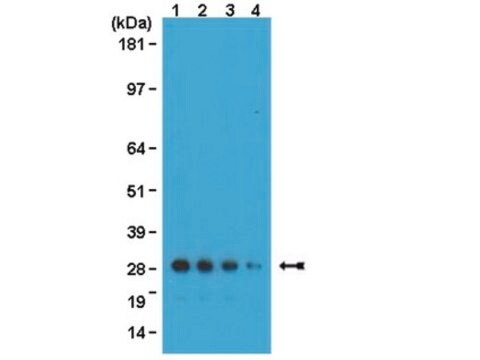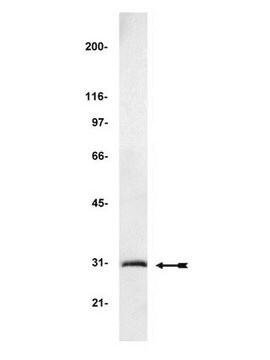MAB3580
Anti-Green Fluorescent Protein Antibody
Chemicon®, from mouse
Sinônimo(s):
GFP, eGFP
About This Item
Produtos recomendados
fonte biológica
mouse
Nível de qualidade
forma do anticorpo
affinity purified immunoglobulin
tipo de produto de anticorpo
primary antibodies
clone
monoclonal
reatividade da espécie (prevista por homologia)
all
fabricante/nome comercial
Chemicon®
técnica(s)
ELISA: suitable
immunocytochemistry: suitable
immunohistochemistry: suitable
western blot: suitable
Isotipo
IgG1
nº de adesão UniProt
modificação pós-traducional do alvo
unmodified
Descrição geral
Especificidade
Imunogênio
Aplicação
Immunocytochemistry: 1:500-1:1,000
Immunohistochemistry: 1:500-1:1,000 on paraformaldehyde fixed tissues with an overnight incubation using Nickel enhanced DAB for detection. Suggested permeabilization method is 0.5% Triton X-100. Recommended blocking buffer is PBS containing BSA and serum from the host of the secondary antibody. Recommended dilution buffer is PBS containing 1 mg/mL of BSA.
ELISA: 1:1,000-1:2,000 in a direct assay.
Optimal working dilutions must be determined by the end user.
Descrição-alvo
forma física
Outras notas
Informações legais
Não está encontrando o produto certo?
Experimente o nosso Ferramenta de seleção de produtos.
recomendado
Código de classe de armazenamento
12 - Non Combustible Liquids
Classe de risco de água (WGK)
WGK 2
Ponto de fulgor (°F)
Not applicable
Ponto de fulgor (°C)
Not applicable
Certificados de análise (COA)
Busque Certificados de análise (COA) digitando o Número do Lote do produto. Os números de lote e remessa podem ser encontrados no rótulo de um produto após a palavra “Lot” ou “Batch”.
Já possui este produto?
Encontre a documentação dos produtos que você adquiriu recentemente na biblioteca de documentos.
Os clientes também visualizaram
Nossa equipe de cientistas tem experiência em todas as áreas de pesquisa, incluindo Life Sciences, ciência de materiais, síntese química, cromatografia, química analítica e muitas outras.
Entre em contato com a assistência técnica










